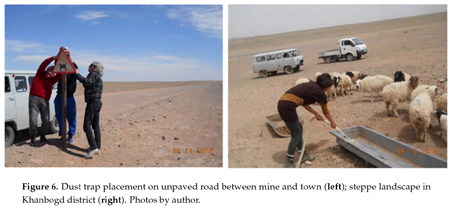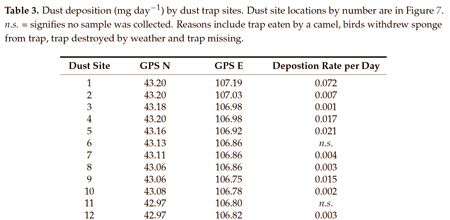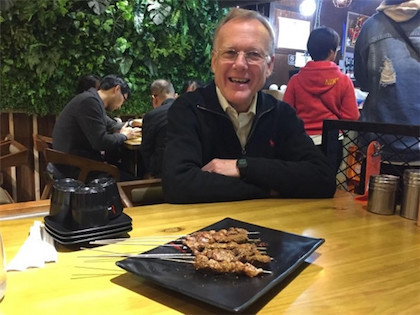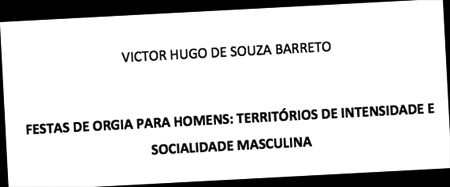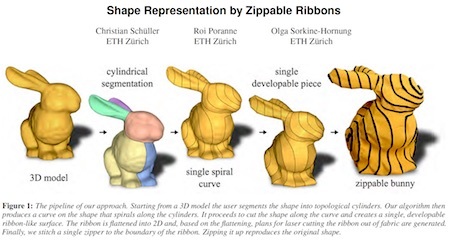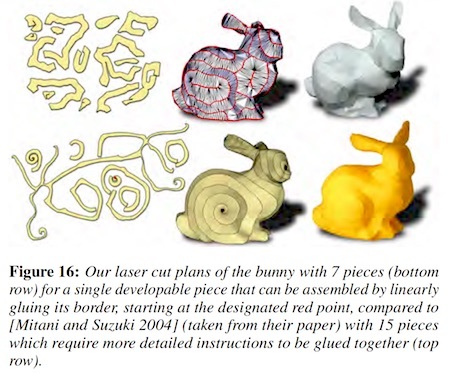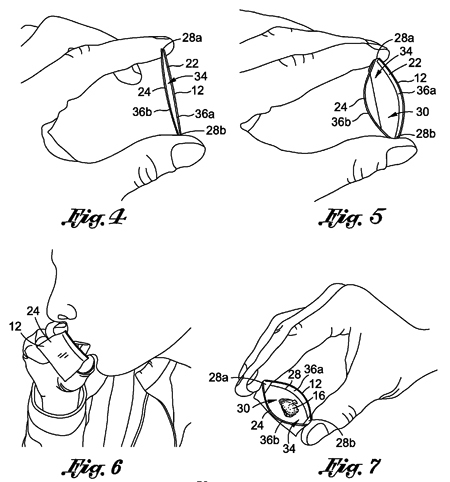Marc Abrahams's Blog, page 204
November 12, 2017
Research Hazard: Instrument Eaten By a Camel
Two researchers appear to be unusually frank, in this study, in telling why some of their data is flawed:
“Desert Dust and Health: A Central Asian Review and Steppe Case Study,” Troy Sternberg and Mona Edwards, International Journal of Environmental Research and Public Health, vol. 14, 2017, p. 1342 ff. The authors, at the University of Oxford, UK, include this explanation for certain items that are listed in Table 3:
“Dust deposition (mg day-1) by dust trap sites. Dust site locations by number are in Figure 7. n.s. = signifies no sample was collected. Reasons include trap eaten by a camel…”
(Thanks to Tom Gill for bringing this to our attention.)

November 11, 2017
The STRANGE QUESTIONS issue of the Annals of Improbable Research
The special Strange Questions issue (vol. 23, no. 5) of the Annals of Improbable Research is now available.
The issue’s table of contents is online. And you can obtain, for a pittance, the full issue, in PDF form.
In this issue you will find, among other things:
Strange Questions*
Strange’s Questions*
Strange Medical Questions*
Are Lung Cancers Triggered by Stopping Smoking?*
Cases of Usmani*
Other Strange Cases*
Biology Questions*
Strange Counting Questions*
Strange Culture Questions*
Strange Economics Questions*
Strange Psychology/Philosophy Questions*
Strange Snake Questions*

‘The Archers’ in academia (UK radio soap conference 2017)
‘The Archers’ is the world’s longest-running radio soap opera. Although the BBC has been transmitting it in the UK for more than 60 years now, it’s only recently been gaining traction in the academic world. See, for example, the 2017 “The Archers in fact and fiction: Academic analyses of life in rural Borsetshire* ” conference which took place 17th-19th February, hosted by University of Lincoln, UK.
The conference featured 32 speakers and 27 papers from universities across the globe, covering such topics as :
• “My parsnips are bigger than your parsnips”: The negative aspects of competing at flower and produce shows. (Cranfield Defence and Security, Cranfield University, UK)
• ‘Big telephoto lens, small ticklist’: birdwatching, class and masculinity in Ambridge* (Sheffield Hallam University, UK)
• The Ambridge* Paradox: Cake Consumption and Metabolic Health in a Defined Rural Population (from Christine Michael, editor of the Ambridge* Observer) [See photo above]
BONUSES
[1] Various YouTube videos of the conference are available here
[2] The Archers theme music
* Note: The town of ‘Ambridge’ does not exist, neither does the county of Borsetshire. Nevertheless, the BBC does, however, provide a map.

November 10, 2017
Named-cow researcher recognizes merit in research on sheep recognizing people
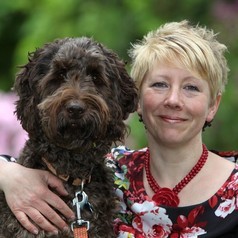 “I was asked if, as an Ig Nobel laureate myself, I thought this recent Cambridge sheep study would be a contender for an Ig Nobel award, the prize for science that “first makes you laugh, then makes you think”. Celebrity-spotting sheep might sound funny but the science involved in this study actually isn’t sniggerable.” So writes Catherine Douglas of Newcastle University, in The Conversation.
“I was asked if, as an Ig Nobel laureate myself, I thought this recent Cambridge sheep study would be a contender for an Ig Nobel award, the prize for science that “first makes you laugh, then makes you think”. Celebrity-spotting sheep might sound funny but the science involved in this study actually isn’t sniggerable.” So writes Catherine Douglas of Newcastle University, in The Conversation.
Douglas’s essay has the headline “Sheep can recognise celebrities from photographs, says amusing study with serious potential.”
The 2009 Ig Nobel Prize for Veterinary Medicine was awarded to Catherine Douglas and Peter Rowlinson of Newcastle University, Newcastle-Upon-Tyne, UK, for showing that cows who have names give more milk than cows that are nameless.
That prize-winning research is documented in the study “Exploring Stock Managers’ Perceptions of the Human-Animal Relationship on Dairy Farms and an Association with Milk Production,” Catherine Bertenshaw [Douglas] and Peter Rowlinson, Anthrozoos, vol. 22, no. 1, March 2009, pp. 59-69

Beijing restaurant gives medical professionals discounted food for thought
China Daily reports:
Lancet restaurant gives medical professionals food for thought
When Feng Shangqing published a paper in a scientific journal, she was simply hoping it would prove beneficial to her medical career. She certainly didn’t imagine that the article would provide her with a discounted treat at a barbecue restaurant in Beijing.
The physician, who graduated from Fourth Military Medical University in Xi’an, Shaanxi province, was given a discount of 84 yuan ($12.67) at a barbecue restaurant that is popular with medical professionals as a result of the paper’s “impact factor”—a measure of the frequency with which articles are cited in a particular year. The 84 yuan discount was a multiple of the paper’s impact factor of 8.4, which is considered a good score.
Under the rules of the restaurant, scientists, medical professionals and social scientists are eligible for a discount if they have recently published papers in journals that are included on internet databases such as the Science Citation Index and the Social Sciences Citation Index.
The paper’s impact factor is multiplied by 10 to determine the discount, which can account for as much as 30 percent of the bill….
The restaurant is named after the medical journal, The Lancet. China Daily earlier reported on a visit to the restaurant by an editor of journal:
Medical journal Lancet’s senior editor visits Lancet grill in Beijing
The popular Beijing grill “The Lancet“, which is named after the famous medical journal, received a special customer on Sunday—William Summerskill, one of the four senior executive editors of the journal, according to the grill’s weibo account.
The grill invested by a group of surgeons and graduates from Tsinghua University and Peking University, caught internet attention in early October when it published an article on its WeChat account on September 21 in which it advertised discounts to scholars whose published papers received influential citation indexes such as SCI, SSCI, and CSSCI in the past five years….

Ph.D. Thesis About Attending Orgies
Victor Hugo De Souza Barreto attended orgies, gathering facts for his Ph.D. thesis. The thesis is:
“Festas ee Orgia Para Homens: Territórios ee Intensidade Esocialidade Masculina,” Victor Hugo De Souza Barreto, doctoral thesis in anthropology, Universidade Federal Fluminense, Brazil, 2016. The author explains:
In this work , I intend to present a reflection on certain sexual practices conducted among men in the city of Rio de Janeiro in orgy meetings, from an ethnography in these four commercially organized events in the city . What the experience of sexuality these parties seem to put into play are other modes of subjectivity and corporalization , properly intensive modes, where at the same time that a particular form of masculinity also is developed there a singular way of engagement in the world.This thesis seeks to understand these interactions by analyzing what I am calling here from the three “principles” of these events: “masculinity“, “discretion” and “putaria.” I also dwell on the debate on methodology of research in contexts of sexual interaction.
(Thanks to J.G. Correa for bringing this to our attention.)
BONUS (related): How to Cater a Roman Orgy for Harvard Professors

November 9, 2017
How to Make Any Shape Zippable [research study]
Mathematics comes to the rescue of anyone who wants to make almost any shape “zippable” with a single zipper. This study has details:
“Shape Representation by Zippable Ribbons,” Christian Schüller, Roi Poranne, and Olga Sorkine-Hornung, arXiv:1711.02450v1, November 7, 2017. The authors, at ETH Zürich, Switzerland, explain:
“We observe that the assembly of complex 3D shapes created by existing methods often requires first fabricating many small flat parts and then carefully following instructions to assemble them together. Despite its significance, this error prone and tedious process is generally neglected in the discussion. We propose an approach for shape representation through a single developable part that attaches to itself and requires no assembly instructions. Our inspiration comes from the so-called zipit bags, which are made of a single, long ribbon with a zipper around its boundary. In order to ‘assemble’ the bag, one simply needs to zip up the ribbon. Our method operates in the same fashion, but it can be used to approximate any shape.”
(Thanks to Mason Porter for bringing this to our attention.)

November 8, 2017
Lamb on Abdominal Ultrasonography in Dogs With Diarrhoea [research study]
Doubts about abdominal ultrasonography in dogs with diarrhoea are discussed in Lamb‘s new treatise:
 “How Useful is Abdominal Ultrasonography in Dogs With Diarrhoea?” Emma K. Mapletoft, Karin Allenspach, and Chris R. Lamb [pictured here], Journal of Small Animal Practice, epub November 2017.
“How Useful is Abdominal Ultrasonography in Dogs With Diarrhoea?” Emma K. Mapletoft, Karin Allenspach, and Chris R. Lamb [pictured here], Journal of Small Animal Practice, epub November 2017.
The authors, at the Royal Veterinary College, UK, report:
“Abdominal ultrasonography had moderate utility in 56 (38%) dogs and no utility in 79 (53%) dogs. Abdominal ultrasonography was considered counterproductive in 10 (7%) dogs because results were either falsely negative or falsely positive.”
BONUS (possibly not related): Here is video of a dog responding to the spoken word “diarrhoea”:

November 7, 2017
Comes the revolution in disposing of chewed gum in restaurants
An invention gives restaurant diners a possibly elegant way to dispose of their chewed chewing gum, and gives restaurants a new means of advertising themselves or anything else. The invention was marketed under the name “Gumvelope.” A patent application tells how Gumvelope works:
“Chewing gum disposal system,” US patent application US20090294321A1, Rebeca Craig, filed June 2, 2008. The patent application explains:
The chewing gum disposal system includes a plurality of chewing gum disposal envelopes configured to receive one or more pieces of chewing gum, and a chewing gum disposal container…. In disposing of a piece of chewing gum, an envelope is removed from the holding compartment, the piece of chewing gum is placed inside the envelope, and the envelope is inserted into the disposal compartment. The chewing gum disposal system and method provide an efficient, sanitary and pleasant method for the disposal of chewing gum that is suitable for public spaces including restaurants, bars, buses, movie theaters, ballparks, stores, malls, and other areas.
This instructional video demonstrates a Gumvelope in use by a gum chewer:
A word-filled press release heralded the coming of Gumvelope. The press release says, in part:
Gumvelope® LAUNCHES REVOLUTIONARY PRODUCT FOR CHEWING GUM DISPOSAL
Newton, Massachusetts – May 27, 2010—Entrepreneur, inventor and avid gum-chewer Rebeca Craig has proudly launched the Gumvelope®, a product aimed at revolutionizing gum disposal for restaurants and food service establishments everywhere….
The birth of the Gumvelope comes from both Craig’s observation and personal practice. “While living in California,” Craig explains, “I began noticing that people in restaurants had no place to dispose of their used chewing gum. In the past, patrons have used linen napkins, straw wrappers, sugar packets and even disposed of their gum by placing it under the table. The problem with those methods of disposal is that they aren’t disposal. Instead, gum has to be painstakingly scraped off of the bottom of tables, which is time-consuming and costly, and disposing of gum in linen napkins simply ruins them. Additionally, there is the problem of having an unpleasant and sticky gum and paper mess sitting on the table as food is being served.”
Frustrated, Craig began thinking of ways to circumvent this ongoing problem. Her solution was a small, self-contained envelope—dubbed a Gumvelope®—In which used gum could be placed. Once sealed, the envelope could be sanitarily disposed of by wait staff or chewer, or temporarily saved and neatly placed in a pocket or purse.
This video shows the inventor explaining Gumvelope to an audience of potential investors. You may find that the sound recording quality is suboptimal:
The company organized to make and market Gumvelopes has apparently been disposed of:
GUMVELOPE LLC is DEREGISTERED BUSINESS company incorporated in Massachusetts with identification number of 001006416. Company was incorporated on 2009-06-17… The type of company is Domestic Limited Liability Company (LLC). Registration address: WEST NEWTON, MA 02465. The officer(s) is/are: REBECA CRAIG.
A trademark for the name “Gumvelope” has also, apparently, been disposed of:
This video ad for Gumvelope lives on:
BONUS: Chewing gum inspires many inventors and scientists. Wads of their research cover the pages of the special Chewing Gum issue of the Annals of Improbable Research:
The issue includes a roundup of some of the research about the “Psycho-Dynamics of Chewing.”

November 6, 2017
Towards standard measurement scales for crispy, crackly and crunchy foods
Those involved in the field of ‘Texture Studies’ (with regard to food) often find a need to measure and categorize crispness, crackliness and crunchiness of various foodstuffs (* see example below). For such measurements to be meaningful, however, the methods and terms need to be accurately defined first.
In 2008 considerable steps towards definitions of techniques used to evaluate crispness, and crackliness and crunchiness were taken by MAITE A. CHAUVIN, FRANK YOUNCE, CAROLYN ROSS and BARRY SWANSON of the Food Science and Human Nutrition department at Washington State University, US, with the publication of their paper : STANDARD SCALES FOR CRISPNESS, CRACKLINESS AND CRUNCHINESS IN DRY AND WET FOODS: RELATIONSHIP WITH ACOUSTICAL DETERMINATIONS
“The developed standard scales for crispness, crunchiness and crackliness for dry and wet foods provide individuals interested in auditory texture evaluation with a starting point to assist in training descriptive analysis of food texture. Although future modifications in reference material, attribute definition or evaluation procedures are expected, this study represents a first step in the generation of reproducible auditory sensory data using standard scales.”
Journal of Texture Studies, 39, (2008) 345–368.
* Note : The 2008 Ig Nobel NUTRITION PRIZE was awarded to Massimiliano Zampini of the University of Trento, Italy and Charles Spence of Oxford University, UK, for electronically modifying the sound of a potato chip to make the person chewing the chip believe it to be crisper and fresher than it really is. REFERENCE: “The Role of Auditory Cues in Modulating the Perceived Crispness and Staleness of Potato Chips,” Massimiliano Zampini and Charles Spence, Journal of Sensory Studies, vol. 19, October 2004, pp. 347-63.

Marc Abrahams's Blog
- Marc Abrahams's profile
- 14 followers


